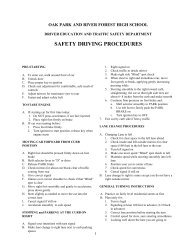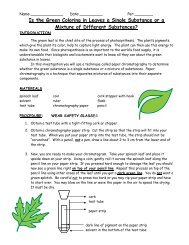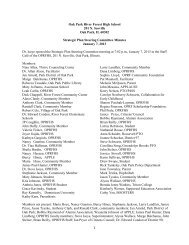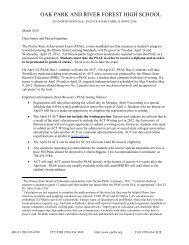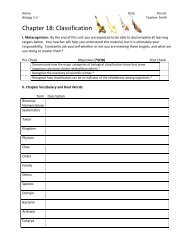energy
energy
energy
Create successful ePaper yourself
Turn your PDF publications into a flip-book with our unique Google optimized e-Paper software.
Chapter 8 Notes
Chemical Reactions<br />
• CHEMICAL REACTION<br />
is the process that<br />
changes one set of<br />
chemicals into another<br />
set of chemicals<br />
– REACTANTS are<br />
compounds that enter the<br />
chemical reaction (what<br />
you start with)<br />
– PRODUCTS are compounds<br />
produced by a chemical<br />
reaction (what you end up<br />
with)
Energy<br />
• ENERGY is the capacity<br />
for doing work or<br />
causing a change in<br />
matter.<br />
– Two forms of <strong>energy</strong>:<br />
• KINETIC <strong>energy</strong> – <strong>energy</strong><br />
that is actively expressed<br />
• POTENTIAL <strong>energy</strong> –<br />
<strong>energy</strong> that represents<br />
the capacity for doing<br />
work or causing change<br />
(stored <strong>energy</strong>)
Laws of Thermodynamics<br />
• FIRST Law of Thermodynamics<br />
– Energy cannot be CREATED nor<br />
DESTROYED<br />
– It can be CHANGED from one form to<br />
another<br />
– Also known as CONSERVATION OF<br />
ENERGY
Laws of Thermodynamics<br />
• SECOND Law of Thermodynamics<br />
– Energy cannot be changed from one form to<br />
another without a LOSS of USEABLE<br />
<strong>energy</strong><br />
– Much of the <strong>energy</strong> is lost in the form of<br />
HEAT<br />
– Heat CANNOT be converted to one of the<br />
other forms of <strong>energy</strong>.
Cells and Entropy<br />
• The second law of thermodynamics can also<br />
be stated as: Every <strong>energy</strong> transformation<br />
makes the universe LESS organized and more<br />
disordered<br />
• ENTROPY is the tendency of the universe to<br />
become disordered<br />
• Living things use <strong>energy</strong> to MAINTAIN their<br />
own organization.<br />
– Without <strong>energy</strong> they would die and decompose<br />
(entropy)<br />
– All living organisms require <strong>energy</strong> for survival<br />
– For this reason, living things are dependent on an<br />
outside source of <strong>energy</strong> that ultimately comes<br />
from the SUN
Cells and Entropy<br />
• All living things need some type of<br />
ENERGY to survive.<br />
• In addition, cells use ENERGY for<br />
everything they do.<br />
• METABOLISM is all of the chemical<br />
changes that occur within an organism<br />
• Where do the cells get this <strong>energy</strong><br />
from?
ATP<br />
• ADENOSINE<br />
TRIPHOSPHATE or<br />
ATP.<br />
– This is a phosphorus<br />
compound that<br />
STORES <strong>energy</strong><br />
(works just like a<br />
battery!! ATP =<br />
<strong>energy</strong> currency of<br />
the cell)
ATP<br />
• Structure:<br />
• ADENINE<br />
• RIBOSE<br />
• 3 PHOSPHATE groups<br />
• ADENOSINE<br />
TRIPHOSPHATE
ADP AND AMP<br />
• ADP – adenosine<br />
DIPHOSPHATE<br />
– Has 2 phosphate<br />
groups<br />
• AMP – adenosine<br />
MONOPHOSPHATE<br />
– Has 1 phosphate<br />
group<br />
– Like an uncharged<br />
battery
ATP and Energy<br />
• It takes ENERGY to attach a phosphate to<br />
AMP or ADP<br />
– (Just like it takes <strong>energy</strong> to push to opposing<br />
magnets together)<br />
• This <strong>energy</strong> is stored in the phosphate<br />
BONDS<br />
• Energy is stored when a phosphate group is<br />
ADDED and a bond is FORMED<br />
• Energy is released when a phosphate group<br />
is RELEASED and a bond is BROKEN
ATP and Energy<br />
• ADP + <strong>energy</strong> + P<br />
ATP<br />
• ATP ADP + P + ENERGY<br />
• ADP forms when ATP releases <strong>energy</strong><br />
• The <strong>energy</strong> released by converting ATP<br />
to ADP provides <strong>energy</strong> for the<br />
MECHANICAL FUNCTIONS of cells
ATP and Energy<br />
• Used ATP is then RECYCLED ADP and P<br />
are used to make more ATP.<br />
• The formation/breakdown recycling<br />
activity is very important because then<br />
cells do not have to STORE all the<br />
ENERGY it needs.<br />
– (Trying to pay for pop with $1 bill vs. $50 bill)<br />
• PHOSPHORALATION is the addition of a<br />
phosphate group to a molecule (involves<br />
the transfer of <strong>energy</strong>)
Where does the <strong>energy</strong> stored in<br />
ATP come from?<br />
1. PHOTOSYNTHESIS is the process by which<br />
green plants use the <strong>energy</strong> of sunlight to<br />
produces high <strong>energy</strong> SUGARS and<br />
STARCHES<br />
1. Occurs in the CHLOROPLAST of a cell<br />
2. CELLULAR RESPIRATION is the breakdown<br />
of food molecules and release of chemical<br />
<strong>energy</strong> within the cell<br />
1. Occurs in the MITOCHONDRIA of a cell.<br />
3. Each step in photosynthesis and respiration<br />
is activated by ATP
Organisms are classified<br />
according to the origin of their<br />
food <strong>energy</strong>.<br />
1. AUTOTROPHS are<br />
organisms, such as<br />
plants, that make their<br />
own food (also called<br />
PRODUCERS).<br />
2. HETEROTROPHS are<br />
organisms that cannot<br />
make their own food<br />
and must obtain <strong>energy</strong><br />
from the food they eat<br />
(also called<br />
CONSUMERS).
Photosynthesis<br />
• Chemical Reaction<br />
• 6CO2 + 6H2O C6H12O6 + 6O2<br />
– Reactants: 6CO2 + 6H2O<br />
– Also needed: ENERGY FROM SUN<br />
– Products: C6H12O6 + 6O2
Summary of Photosynthesis<br />
• Needed by plants for photosynthesis:<br />
SUNLIGHT, CARBON DIOXIDE and<br />
WATER<br />
• Produced by plants during<br />
photosynthesis: high <strong>energy</strong> SUGARS<br />
and STARCHES<br />
• The gas GIVEN OFF by plants during<br />
photosynthesis: OXYGEN<br />
• Place in the eukaryotic cell where<br />
photosynthesis takes place:<br />
CHLOROPLASTS
CHLOROPLAST<br />
STEM<br />
BLADE
Structure of the Chloroplast<br />
• THYLAKOIDS: membranes are<br />
flattened disk shapes membranes that<br />
contain PHOTOSYSTEMS<br />
• STROMA is the region outside of the<br />
thylakoids<br />
• GRANA: is a stack of thylakoids<br />
• PHOTOSYSTEM: is the place in the<br />
chloroplast where chlorophyll is found
Chloroplast<br />
STROMA<br />
THYLAKOID<br />
PHOTOSYSTEMS -<br />
CHLOROPHYLL (INSIDE)<br />
GRANA<br />
DOUBLE MEMBRANE
Light Absorption<br />
• Plants take in the sun’s <strong>energy</strong> by<br />
absorbing SUNLIGHT<br />
• PHOTOSYSTEMS are clusters of pigments<br />
used as light-collecting units<br />
– PIGMENTS are substances that absorb visible<br />
light<br />
– Found in the<br />
THYLAKOID<br />
MEMBRANE<br />
– This is where<br />
CHLOROPHYLL<br />
pigment can be<br />
found
Chlorophyll<br />
• Absorb red, orange, yellow, blue, and<br />
violet light<br />
• Reflect GREEN light; This makes plants<br />
look GREEN<br />
• Most important function is that they<br />
ABSORB light <strong>energy</strong><br />
• Two types: chlorophyll A and chlorophyll<br />
B<br />
• When chlorophyll absorbs light, much of<br />
the <strong>energy</strong> from that light is used to<br />
make PHOTOSYNTHESIS work
Accessory Pigments<br />
• Plants also contain ACESSORY pigments<br />
such as carotene that absorb light in<br />
other regions of the spectrum.<br />
• Most of the time, the GREEN COLOR of<br />
the chlorophyll OVERWHELMS OR<br />
HIDES the other pigments, but as THE<br />
TEMPERATURE DROPS THE<br />
CHLOROPHYLL MOLECULES BREAK<br />
DOWN FIRST, LEAVING THE<br />
REDS/ORANGES OF THE ACCESSORY<br />
PIGMENTS TO SEE
Summary of Photosynthesis
LIGHT DEPENDENT<br />
REACTIONS (REQUIRE light)<br />
• Produce O2 (Oxygen gas),<br />
ATP, AND NADPH<br />
• NADP+ is an electron<br />
carrier and holds two<br />
HIGH ENERGY electrons,<br />
along with an H+ ion<br />
(another way that some<br />
<strong>energy</strong> of sunlight can be<br />
trapped in CHEMICAL<br />
FORM)<br />
• Take place in the<br />
THYLAKOID MEMBRANE
Light Absorbtion<br />
• Energy from light and WATER is used<br />
to make ATP and NADPH<br />
• The leftovers after making ATP and<br />
NADPH is O2<br />
– Which is released from the plant as a<br />
“waste” product
LIGHT INDEPENDENT REACTIONS<br />
(does NOT require light)<br />
• Energy from ATP and NADPH is used to<br />
build high <strong>energy</strong> compounds that can be<br />
USED for a long time<br />
– ATP and NADPH are SHORT-TERM <strong>energy</strong><br />
carriers
Light Independent Reactions<br />
• This is also known as the CALVIN cycle<br />
• Produces high <strong>energy</strong> SUGARS and<br />
STARCHES<br />
• Uses ENERGY from ATP and NADPH<br />
• Also uses CO2 (Carbon Dioxide) to make<br />
sugars<br />
• Takes place in the STROMA of the<br />
chloroplast
Summary of Photosynthesis
Factors that affect the rate of<br />
photosynthesis<br />
• LIGHT intensity an increase in light<br />
increases the rate of photosynthesis<br />
until all electrons are excited and then<br />
the rate of photosynthesis will level out
Factors that affect the rate of<br />
photosynthesis<br />
• TEMPERATURE The rate of<br />
photosynthesis will increase up to 45°C<br />
(115°F) and then decrease above 45°C<br />
(less than optimal rate)
Factors that affect the rate of<br />
photosynthesis<br />
• CARBON DIOXIDE more CO2<br />
present increases the amount of sugar<br />
made
Factors that affect the rate of<br />
photosynthesis<br />
• WATER without enough water the<br />
rate of photosynthesis goes down
Photosynthesis Under Extreme<br />
Conditions<br />
• C4 PLANTS have a special chemical pathway<br />
that allows them to capture very low levels of<br />
CO2<br />
– Photosynthesis can keep working under INTENSE<br />
LIGHT AND HIGH TEMPERATURES<br />
– Requires extra ATP<br />
– Examples: corn, sugar cane, sorghum<br />
• CAM PLANTS admit air into their leaves only at<br />
night and traps carbon in the leaves<br />
– During the daytime the carbon dioxide is released so<br />
sugars can be made<br />
– Photosynthesis can keep working in DRY CLIMATES<br />
– Examples: pineapple trees, desert cacti, icy plants
C4 Plants
CAM Plants



